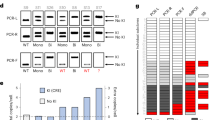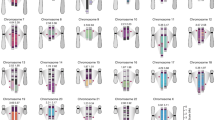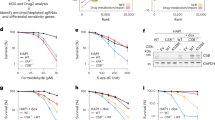Abstract
We investigated 67 breakpoint junctions of gene copy number gains in 31 unrelated subjects. We observed a strikingly high frequency of small deletions and insertions (29%) apparently originating from polymerase slippage events, in addition to frameshifts and point mutations in homonucleotide runs (13%), at or flanking the breakpoint junctions of complex copy number variants. These single-nucleotide variants were generated concomitantly with the de novo complex genomic rearrangement (CGR) event. Our findings implicate low-fidelity, error-prone DNA polymerase activity in synthesis associated with DNA repair mechanisms as the cause of local increase in point mutation burden associated with human CGR.
This is a preview of subscription content, access via your institution
Access options
Subscribe to this journal
Receive 12 print issues and online access
$209.00 per year
only $17.42 per issue
Buy this article
- Purchase on Springer Link
- Instant access to full article PDF
Prices may be subject to local taxes which are calculated during checkout




Similar content being viewed by others
Accession codes
Primary accessions
Gene Expression Omnibus
Referenced accessions
NCBI Reference Sequence
References
Zhang, F., Carvalho, C.M. & Lupski, J.R. Complex human chromosomal and genomic rearrangements. Trends Genet. 25, 298–307 (2009).
Liu, P., Carvalho, C.M., Hastings, P.J. & Lupski, J.R. Mechanisms for recurrent and complex human genomic rearrangements. Curr. Opin. Genet. Dev. 22, 211–220 (2012).
Conrad, D.F. et al. Mutation spectrum revealed by breakpoint sequencing of human germline CNVs. Nat. Genet. 42, 385–391 (2010).
Kidd, J.M. et al. A human genome structural variation sequencing resource reveals insights into mutational mechanisms. Cell 143, 837–847 (2010).
Bauters, M. et al. Nonrecurrent MECP2 duplications mediated by genomic architecture–driven DNA breaks and break-induced replication repair. Genome Res. 18, 847–858 (2008).
Carvalho, C.M. et al. Complex rearrangements in patients with duplications of MECP2 can occur by fork stalling and template switching. Hum. Mol. Genet. 18, 2188–2203 (2009).
Carvalho, C.M. et al. Inverted genomic segments and complex triplication rearrangements are mediated by inverted repeats in the human genome. Nat. Genet. 43, 1074–1081 (2011).
Carvalho, C.M. et al. Evidence for disease penetrance relating to CNV size: Pelizaeus-Merzbacher disease and manifesting carriers with a familial 11 Mb duplication at Xq22. Clin. Genet. 81, 532–541 (2012).
Lee, J.A., Carvalho, C.M. & Lupski, J.R.A. DNA replication mechanism for generating nonrecurrent rearrangements associated with genomic disorders. Cell 131, 1235–1247 (2007).
Zhang, F. et al. The DNA replication FoSTeS/MMBIR mechanism can generate genomic, genic and exonic complex rearrangements in humans. Nat. Genet. 41, 849–853 (2009).
Zhang, F. et al. Identification of uncommon recurrent Potocki-Lupski syndrome–associated duplications and the distribution of rearrangement types and mechanisms in PTLS. Am. J. Hum. Genet. 86, 462–470 (2010).
Zhang, F. et al. Mechanisms for nonrecurrent genomic rearrangements associated with CMT1A or HNPP: rare CNVs as a cause for missing heritability. Am. J. Hum. Genet. 86, 892–903 (2010).
Bi, W. et al. Increased LIS1 expression affects human and mouse brain development. Nat. Genet. 41, 168–177 (2009).
Liu, P. et al. Copy number gain at Xp22.31 includes complex duplication rearrangements and recurrent triplications. Hum. Mol. Genet. 20, 1975–1988 (2011).
Neumann, R., Lawson, V.E. & Jeffreys, A.J. Dynamics and processes of copy number instability in human γ-globin genes. Proc. Natl. Acad. Sci. USA 107, 8304–8309 (2010).
Nicholls, R.D., Fischel-Ghodsian, N. & Higgs, D.R. Recombination at the human α-globin gene cluster: sequence features and topological constraints. Cell 49, 369–378 (1987).
Rugless, M.J. et al. A large deletion in the human α-globin cluster caused by a replication error is associated with an unexpectedly mild phenotype. Hum. Mol. Genet. 17, 3084–3093 (2008).
Bayat, V. et al. Mutations in the mitochondrial methionyl-tRNA synthetase cause a neurodegenerative phenotype in flies and a recessive ataxia (ARSAL) in humans. PLoS Biol. 10, e1001288 (2012).
Oshima, J. et al. Regional genomic instability predisposes to complex dystrophin gene rearrangements. Hum. Genet. 126, 411–423 (2009).
Lin, Y. & Waldman, A.S. Promiscuous patching of broken chromosomes in mammalian cells with extrachromosomal DNA. Nucleic Acids Res. 29, 3975–3981 (2001).
Lin, Y. & Waldman, A.S. Capture of DNA sequences at double-strand breaks in mammalian chromosomes. Genetics 158, 1665–1674 (2001).
Slack, A., Thornton, P.C., Magner, D.B., Rosenberg, S.M. & Hastings, P.J. On the mechanism of gene amplification induced under stress in Escherichia coli. PLoS Genet. 2, e48 (2006).
Hastings, P.J., Ira, G. & Lupski, J.R. A microhomology-mediated break-induced replication model for the origin of human copy number variation. PLoS Genet. 5, e1000327 (2009).
Hastings, P.J., Lupski, J.R., Rosenberg, S.M. & Ira, G. Mechanisms of change in gene copy number. Nat. Rev. Genet. 10, 551–564 (2009).
Small, K., Iber, J. & Warren, S.T. Emerin deletion reveals a common X-chromosome inversion mediated by inverted repeats. Nat. Genet. 16, 96–99 (1997).
Carvalho, C.M., Zhang, F. & Lupski, J.R. Structural variation of the human genome: mechanisms, assays, and role in male infertility. Syst. Biol. Reprod. Med. 57, 3–16 (2011).
Lynch, M. Rate, molecular spectrum, and consequences of human mutation. Proc. Natl. Acad. Sci. USA 107, 961–968 (2010).
Campbell, C.D. et al. Estimating the human mutation rate using autozygosity in a founder population. Nat. Genet. 44, 1277–1281 (2012).
Conrad, D.F. et al. Variation in genome-wide mutation rates within and between human families. Nat. Genet. 43, 712–714 (2011).
Kong, A. et al. Rate of de novo mutations and the importance of father's age to disease risk. Nature 488, 471–475 (2012).
Roach, J.C. et al. Analysis of genetic inheritance in a family quartet by whole-genome sequencing. Science 328, 636–639 (2010).
Wang, J., Fan, H.C., Behr, B. & Quake, S.R. Genome-wide single-cell analysis of recombination activity and de novo mutation rates in human sperm. Cell 150, 402–412 (2012).
Lupski, J.R. Genomic rearrangements and sporadic disease. Nat. Genet. 39, S43–S47 (2007).
Nachman, M.W. & Crowell, S.L. Estimate of the mutation rate per nucleotide in humans. Genetics 156, 297–304 (2000).
Mills, R.E. et al. An initial map of insertion and deletion (INDEL) variation in the human genome. Genome Res. 16, 1182–1190 (2006).
Sun, J.X. et al. A direct characterization of human mutation based on microsatellites. Nat. Genet. 44, 1161–1165 (2012).
Cleary, J.D. & Pearson, C.E. Replication fork dynamics and dynamic mutations: the fork-shift model of repeat instability. Trends Genet. 21, 272–280 (2005).
Liu, P. et al. Chromosome catastrophes involve replication mechanisms generating complex genomic rearrangements. Cell 146, 889–903 (2011).
Stephens, P.J. et al. Massive genomic rearrangement acquired in a single catastrophic event during cancer development. Cell 144, 27–40 (2011).
Chen, J.M., Chuzhanova, N., Stenson, P.D., Ferec, C. & Cooper, D.N. Complex gene rearrangements caused by serial replication slippage. Hum. Mutat. 26, 125–134 (2005).
Chen, J.M., Chuzhanova, N., Stenson, P.D., Ferec, C. & Cooper, D.N. Intrachromosomal serial replication slippage in trans gives rise to diverse genomic rearrangements involving inversions. Hum. Mutat. 26, 362–373 (2005).
Chen, J.M., Chuzhanova, N., Stenson, P.D., Ferec, C. & Cooper, D.N. Meta-analysis of gross insertions causing human genetic disease: novel mutational mechanisms and the role of replication slippage. Hum. Mutat. 25, 207–221 (2005).
McEachern, M.J. & Haber, J.E. Break-induced replication and recombinational telomere elongation in yeast. Annu. Rev. Biochem. 75, 111–135 (2006).
Smith, C.E., Llorente, B. & Symington, L.S. Template switching during break-induced replication. Nature 447, 102–105 (2007).
Arlt, M.F., Rajendran, S., Birkeland, S.R., Wilson, T.E. & Glover, T.W. De novo CNV formation in mouse embryonic stem cells occurs in the absence of Xrcc4-dependent nonhomologous end joining. PLoS Genet. 8, e1002981 (2012).
Deem, A. et al. Break-induced replication is highly inaccurate. PLoS Biol. 9, e1000594 (2011).
Hicks, W.M., Kim, M. & Haber, J.E. Increased mutagenesis and unique mutation signature associated with mitotic gene conversion. Science 329, 82–85 (2010).
Shah, K.A. et al. Role of DNA polymerases in repeat-mediated genome instability. Cell Rep. 2, 1088–1095 (2012).
Iraqui, I. et al. Recovery of arrested replication forks by homologous recombination is error-prone. PLoS Genet. 8, e1002976 (2012).
Shinawi, M. et al. Recurrent reciprocal 16p11.2 rearrangements associated with global developmental delay, behavioural problems, dysmorphism, epilepsy, and abnormal head size. J. Med. Genet. 47, 332–341 (2010).
Acknowledgements
We thank the families for their participation in the study. We gratefully acknowledge G. Ira for helpful discussions. This work was supported in part by US National Institute of Neurological Disorders and Stroke (NINDS) grants R01 NS058529 to J.R.L. and 5K08NS062711 to M.B.R, the Conselho Nacional de Desenvolvimento Científico e Tecnológico (CNPq), a Young Investigator fellowship from the Science without Borders Program to C.M.B.C. and the National Human Genome Research Institute (NHGRI) grant 5U54HG006542. The content is solely the responsibility of the authors and does not necessarily represent the official views of the NINDS or the US National Institutes of Health.
Author information
Authors and Affiliations
Contributions
C.M.B.C. conducted high-density aCGH, breakpoint sequencing and data analysis. D.P. assisted with high-density aCGH and breakpoint sequencing. C.M.B.C. and B.A. designed, performed and implemented microsatellite repeat experiments. M.B.R. coordinated clinical studies and subject recruitment. L.M.F. and J.W.B. conducted SNP genotyping and data analysis. P.F. conducted confirmatory CNV studies. P.J.H. and J.R.L. were involved in research design and data analyses. C.M.B.C., P.J.H. and J.R.L. prepared the manuscript.
Corresponding author
Ethics declarations
Competing interests
J.R.L. is a paid consultant for Athena Diagnostics, holds stock ownership in 23andMe, Inc., and Ion Torrent Systems, Inc., and is a coinventor on multiple US and European patents related to molecular diagnostics. The Department of Molecular and Human Genetics at Baylor College of Medicine derives revenue from molecular genetic testing offered in the Medical Genetics Laboratories (http://www.bcm.edu/geneticlabs/).
Supplementary information
Supplementary Text and Figures
Supplementary Figures 1–6 and Supplementary Tables 1 and 2 (PDF 2897 kb)
Rights and permissions
About this article
Cite this article
Carvalho, C., Pehlivan, D., Ramocki, M. et al. Replicative mechanisms for CNV formation are error prone. Nat Genet 45, 1319–1326 (2013). https://doi.org/10.1038/ng.2768
Received:
Accepted:
Published:
Issue Date:
DOI: https://doi.org/10.1038/ng.2768
This article is cited by
-
Mechanisms of structural chromosomal rearrangement formation
Molecular Cytogenetics (2022)
-
CNVs are associated with genomic architecture in a songbird
BMC Genomics (2018)
-
Detection and visualization of complex structural variants from long reads
BMC Bioinformatics (2018)
-
γ-glutamyl transpeptidase deficiency caused by a large homozygous intragenic deletion in GGT1
European Journal of Human Genetics (2018)
-
A case with concurrent duplication, triplication, and uniparental isodisomy at 1q42.12-qter supporting microhomology-mediated break-induced replication model for replicative rearrangements
Molecular Cytogenetics (2017)



